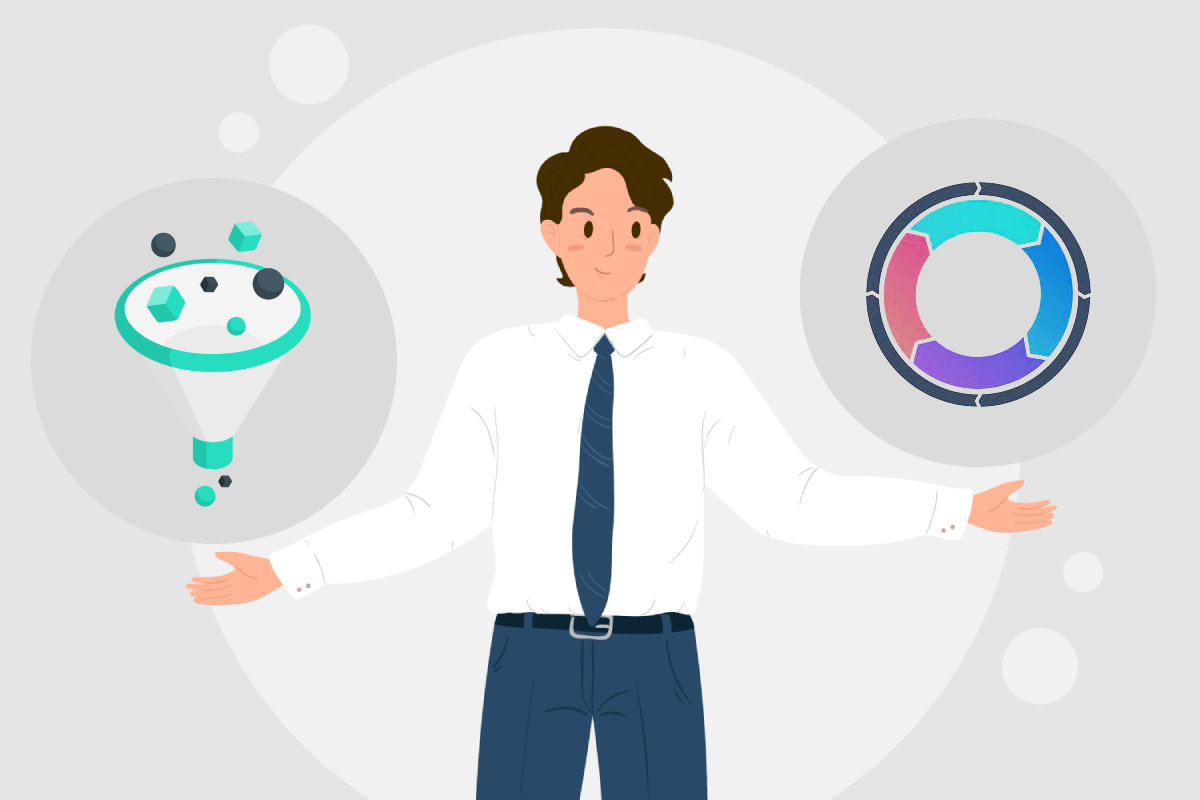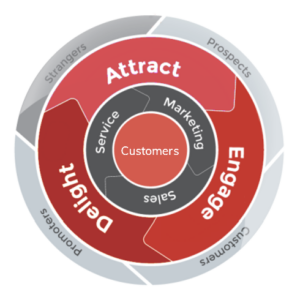
The sales funnel is one of the most used business frameworks ever. But there is a new framework named flywheel, that is trying to get the funnel out of the spotlight. Is the flywheel really a game changer, or is the funnel still relevant?
The sales funnel has historically emerged as a particularly good tool for marketing and sales. The flywheel is one of the models that is based on it. To understand the flywheel, it is crucial to first understand the sales funnel.
In the last article, Sales Funnel Is Dead. Long Live Customer Lifetime Value! we discussed two different approaches to customers and business in general. While the sales funnel’s aim is the acquisition of new customers, Customer Lifetime Value, on the other hand, focuses on retaining existing customers.
The aim of the flywheel, first defined by Jim Collins in his book Good to Great, is to completely replace the funnel. Which is not entirely impossible since the flywheel, unlike the funnel, has a strong focus on existing customers. So, what makes the flywheel better than the sales funnel?
Customers are the center of the universe
The role of customers is the biggest difference between the sales funnel and the flywheel. While in the funnel it is potential customers who travel down the funnel until there is a closed deal, the flywheel, on the contrary, continuously revolves around them. The fact that completing one order doesn't end the relation with a customer is crucial.

Today, customers resist advertising more than ever. The recommendations of family, friends, colleagues, or other customers are becoming increasingly important. That is why the flywheel focuses on customer service as well as marketing and sales. In other words, the satisfaction of existing customers is just as important as the acquisition of new ones. Satisfied customers not only shop regularly, but also become advocates of their favorite brand and recommend it to potentially new customers.
How to spin the flywheel?
If you want your customers to become true advocates of your brand, it is necessary to understand how essential it is that everything revolves around them. At first glance, the flywheel is not as revolutionary when compared to the sales funnel. It also goes through several phases, including a new phase called Service. But the pro-customer approach is important to all of the phases of the flywheel. The whole company should pursue a common goal and everyone in the team should become a customer success manager.
Sure, companies have marketing, sales, and customer service specialists, and it makes perfect sense. But it might be difficult to bridge the gap between the marketing and the sales teams, and the flywheel, unlike the sales funnel, is capable of doing so. So, what do the phases of the flywheel look like?
Attract: Offer customers real value
Customers will always have a choice of many options. In a world full of information, customers are searching for details about the product and service in advance. Reviews or case studies will tell them what other customers' experiences are like.
A significant number of users share their experience via good old word-of-mouth, and therefore it is necessary to pay at least as much attention to existing customers as to new ones. For example, free shipping or favorable return policies will attract new customers, but will definitely please existing ones too.
Engage: Make shopping easier for customers
Engaging a potential customer is a skill that should be followed by the ability to make shopping simple and more enjoyable for customers. For a company to succeed, it must understand the customer and their needs, which can be found out in real time, either on an available customer support phone line or via chat box on websites or social networks.
However, you can also deal with possible dead ends in the purchasing process in more passive ways. For example, helpful blog articles or videos can introduce customers to a product or service or answer any recurring questions.
Delight: The joy of shopping
The last phase of delight is really missing in the sales funnel and it is strongly linked with the attract phase. It simply pays to think about returning customers. Have you noticed that the vast majority of discounts and promotions are aimed at acquiring new customers? In the long run, it’s not a mistake to reward the returning ones at least occasionally. In addition to rewards for returning customers, it is definitely worth paying attention to improving customer support.
The flywheel does not replace the sales funnel, but complements it
Customers become advocates of their favorite brand when their shopping experience is repeatedly enjoyable. Ultimately, it is the delight phase that makes the flywheel more advanced when compared to the sales funnel. If the sales funnel always had a weak spot, it was its bottom. The new customer who completed the purchase then went for another purchase in most companies as a blank slate.
So what does a company need to make their experience more enjoyable for regular customers? Manage customer data, respond to their feedback, or automate the purchasing process. CRM systems are already helping companies complete these objectives. Allowing you to manage marketing, sales and customer service in one place.
If you use a CRM, you probably have your own sales and marketing pipeline set up. It usually comes from the sales funnel, so the flywheel does not bring anything revolutionary to the marketing, sales, or service itself. Rather, it connects existing marketing and sales funnels. However, the idea of linking all of the phases of the purchasing process into a repetitive cycle is very inspiring.
| TIP: To spin your flywheel, take advantage of the automation options that CRM systems offer. Connect your marketing and sales in eWay-CRM. Thanks to detailed statistics, you can find out which respondents have shown interest in specific products. You can easily filter them and convert them into a deal. |











